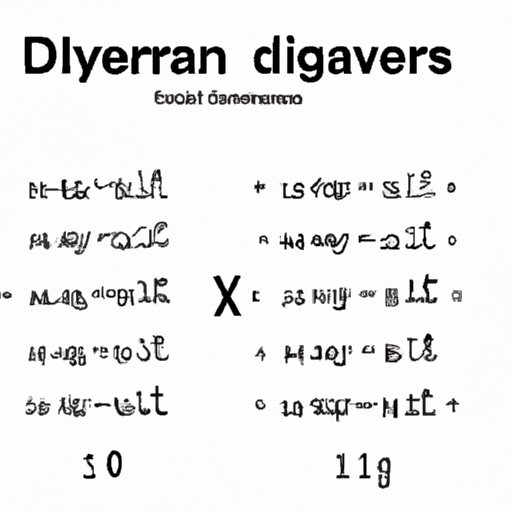
I. Introduction
Long division is a problem many people have encountered at some point in their lives. Whether you’re trying to divide up a pizza evenly between friends or tackling a complex math problem, understanding long division is an essential skill. Follow this step-by-step guide to master long division with ease.
II. A Step-by-Step Guide on How to Do Long Division
Before diving into the steps, let’s define some key terms:
- Dividend: The number we are dividing. This goes inside the “long division box.”
- Divisor: The number we are dividing by. This goes outside the “long division box.”
- Quotient: The answer to the division problem.
- Remainder: The leftover amount after dividing.
Here’s how to perform long division:
- Start by writing the dividend inside the division box with the divisor written outside to the left of the box.
- Ask yourself, “How many times does the divisor go into the first digit of the dividend?” Write this number on top of the long division box.
- Multiply the divisor by the number you just wrote above and write that underneath the first digit of the dividend.
- Subtract the number you just wrote from the first digit of the dividend and write the answer underneath.
- Bring down the next digit of the dividend and write it next to the remainder.
- Repeat steps 2-5 with the new number and the remainder until you reach the end of the dividend.
- If there is a remainder, write it next to the quotient as a fraction.
Let’s try it with a practice problem: 472 ÷ 8. Bring down the first digit of the dividend, which is 4. 8 goes into 4 zero times, so we write a 0 on top of the box. We then multiply 0 x 8 = 0, which we write below 4 and find the difference between 4 and 0 is 4. We bring down the next digit of the dividend, which is 7, and repeat the process, finding that 8 goes into 47 five times. We multiply 5 x 8 = 40, and then subtract 40 from 47 to get 7. Finally, we bring down the last digit of the dividend, which is 2, and find that 8 goes into 72 nine times, and since 9 x 8 = 72, there is no remainder. Therefore, the quotient is 59.
III. Tips and Tricks to Make Long Division Easier and Less Daunting
Long division can be a lengthy process, but here are some tips to make it faster and easier:
- Estimate – rounding the dividend to the nearest ten or hundred can help simplify the problem.
- Break it Down – If possible, break the problem down into smaller parts. For example, use the distributive property to break the dividend into two parts that are easier to divide.
- Use graphs or visuals – Drawing a picture or graph can be useful in figuring out some division problems.

IV. Common Mistakes to Avoid When Doing Long Division
It’s easy to make mistakes while doing long division, but recognizing common errors can help you avoid them. Here are some common mistakes:
- Forgetting to multiply the quotient by the divisor during subtraction.
- Placing the quotient in the wrong place or forgetting to bring down a digit.
- Attempting to divide by zero.
Be sure to double-check your work before finishing a problem.
V. Historical Development and Evolution of Long Division
Long division has been around for centuries and has undergone multiple changes throughout history. The method we use today was first recorded by the Chinese in the 1200s and gradually came into use in Europe and the Americas.
VI. Different Methods of Long Division Used in Various Cultures and Countries
Long division is not performed in the same way worldwide. Here are examples of different methods used in different countries and cultures:
- The bus stop method, commonly used in the UK, involves a symbol-based system that looks like a bus stop sign.
- The chunking method, commonly used in Australia, breaks the problem down into smaller, more manageable parts.
- The partial quotient division method, commonly used in the US, involves dividing by multiples of the divisor and adding the partial quotients together.
Each method has its advantages and disadvantages, depending on the problem.
VII. How to Teach Long Division to Younger Children in a Fun and Engaging Way
Teaching long division to children can be challenging, but there are ways to make it more relatable and fun. Here are some ideas:
- Use real-life examples – Show children how division is used in everyday life, such as dividing up a pizza to be shared.
- Use games – Games like bingo or board games that involve division can make the process more entertaining.
- Resources for parents and teachers – Websites like Khan Academy offer videos and tutorials to help parents and teachers explain the process to children.
VIII. Practical Applications of Long Division in Everyday Life and Careers
Long division has practical applications in everyday life and various careers, including:
- Finance – Calculating taxes, mortgages, and loans.
- Cooking – Adjusting recipes to yield certain amounts of food.
- Crafting – Measuring materials for projects.
- Science – Calculating the velocity of an object over time.
IX. Conclusion
While long division may seem daunting, with practice, anyone can master it. Remember to take it step by step, look for ways to simplify the problem, and avoid common mistakes. Understanding long division has practical applications in many areas of life, making it an essential skill to have.





